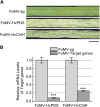Foxtail Mosaic Virus-Induced Gene Silencing in Monocot Plants
- PMID: 27225900
- PMCID: PMC4936545
- DOI: 10.1104/pp.16.00010
Foxtail Mosaic Virus-Induced Gene Silencing in Monocot Plants
Abstract
Virus-induced gene silencing (VIGS) is a powerful technique to study gene function in plants. However, very few VIGS vectors are available for monocot plants. Here we report that Foxtail mosaic virus (FoMV) can be engineered as an effective VIGS system to induce efficient silencing of endogenous genes in monocot plants including barley (Hordeum vulgare L.), wheat (Triticum aestivum) and foxtail millet (Setaria italica). This is evidenced by FoMV-based silencing of phytoene desaturase (PDS) and magnesium chelatase in barley, of PDS and Cloroplastos alterados1 in foxtail millet and wheat, and of an additional gene IspH in foxtail millet. Silencing of these genes resulted in photobleached or chlorosis phenotypes in barley, wheat, and foxtail millet. Furthermore, our FoMV-based gene silencing is the first VIGS system reported for foxtail millet, an important C4 model plant. It may provide an efficient toolbox for high-throughput functional genomics in economically important monocot crops.
© 2016 American Society of Plant Biologists. All Rights Reserved.
Figures




Similar articles
-
A Foxtail mosaic virus Vector for Virus-Induced Gene Silencing in Maize.Plant Physiol. 2016 Jun;171(2):760-72. doi: 10.1104/pp.16.00172. Epub 2016 Apr 28. Plant Physiol. 2016. PMID: 27208311 Free PMC article.
-
Virus-Induced Gene Silencing in Poaceae Using a Foxtail Mosaic Virus Vector.Methods Mol Biol. 2020;2172:15-25. doi: 10.1007/978-1-0716-0751-0_2. Methods Mol Biol. 2020. PMID: 32557358
-
Barley stripe mosaic virus-induced gene silencing in a monocot plant.Plant J. 2002 May;30(3):315-27. doi: 10.1046/j.1365-313x.2002.01291.x. Plant J. 2002. PMID: 12000679
-
Foxtail mosaic virus: A tool for gene function analysis in maize and other monocots.Mol Plant Pathol. 2023 Jul;24(7):811-822. doi: 10.1111/mpp.13330. Epub 2023 Apr 10. Mol Plant Pathol. 2023. PMID: 37036421 Free PMC article. Review.
-
Foxtail millet: a model crop for genetic and genomic studies in bioenergy grasses.Crit Rev Biotechnol. 2013 Sep;33(3):328-43. doi: 10.3109/07388551.2012.716809. Epub 2012 Sep 18. Crit Rev Biotechnol. 2013. PMID: 22985089 Review.
Cited by
-
Development of cassava common mosaic virus-based vector for protein expression and gene editing in cassava.Plant Methods. 2023 Aug 3;19(1):78. doi: 10.1186/s13007-023-01055-5. Plant Methods. 2023. PMID: 37537660 Free PMC article.
-
Genome-Wide Identification and Expression Analysis of the Histone Deacetylase Gene Family in Wheat (Triticum aestivum L.).Plants (Basel). 2020 Dec 24;10(1):19. doi: 10.3390/plants10010019. Plants (Basel). 2020. PMID: 33374252 Free PMC article.
-
Multi-omics intervention in Setaria to dissect climate-resilient traits: Progress and prospects.Front Plant Sci. 2022 Aug 31;13:892736. doi: 10.3389/fpls.2022.892736. eCollection 2022. Front Plant Sci. 2022. PMID: 36119586 Free PMC article. Review.
-
Genetics and Genomics Interventions for Promoting Millets as Functional Foods.Curr Genomics. 2021 Oct 18;22(3):154-163. doi: 10.2174/1389202922666210225084212. Curr Genomics. 2021. PMID: 34975288 Free PMC article. Review.
-
Foxtail mosaic virus: A Viral Vector for Protein Expression in Cereals.Plant Physiol. 2018 Aug;177(4):1352-1367. doi: 10.1104/pp.17.01679. Epub 2018 Jun 7. Plant Physiol. 2018. PMID: 29880705 Free PMC article.
References
-
- Bancroft JB, Rouleau M, Johnston R, Prins L, Mackie GA (1991) The entire nucleotide sequence of foxtail mosaic virus RNA. J Gen Virol 72: 2173–2181 - PubMed
-
- Baulcombe D. (2004) RNA silencing in plants. Nature 431: 356–363 - PubMed
-
- Becker A, Lange M (2010) VIGS—genomics goes functional. Trends Plant Sci 15: 1–4 - PubMed
-
- Bennetzen JL, Schmutz J, Wang H, Percifield R, Hawkins J, Pontaroli AC, Estep M, Feng L, Vaughn JN, Grimwood J, Jenkins J, Barry K, et al. (2012) Reference genome sequence of the model plant Setaria. Nat Biotechnol 30: 555–561 - PubMed
-
- Bruun-Rasmussen M, Madsen CT, Johansen E, Albrechtsen M (2008) Revised sequence of foxtail mosaic virus reveals a triple gene block structure similar to potato virus X. Arch Virol 153: 223–226 - PubMed
Publication types
MeSH terms
Substances
LinkOut - more resources
Full Text Sources
Other Literature Sources
Miscellaneous

